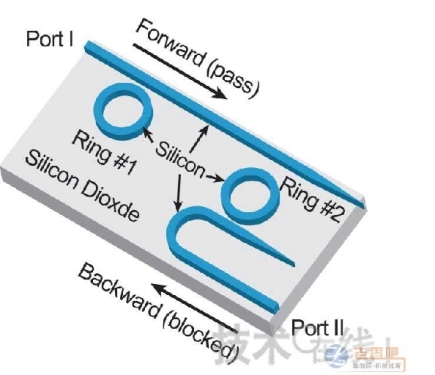 This is achieved by forming a Si optical waveguide (containing a ring resonator) on a SiO2 substrate. The size of ring resonators #1 (NF) and #2 (ADF) is the same, but the distance of the optical waveguide connected to port 1 is different.
This is achieved by forming a Si optical waveguide (containing a ring resonator) on a SiO2 substrate. The size of ring resonators #1 (NF) and #2 (ADF) is the same, but the distance of the optical waveguide connected to port 1 is different. Purdue University and the Shanghai Institute of Microsystems and Information Technology of the Chinese Academy of Sciences announced that researchers at the university use only silicon materials that are compatible with CMOS technology. The source element implements "photodiode" (in English). This element assumes the use of light having a wavelength of 1.5 to 1.6 μm used in optical communications. The ratio of the signal power when the optical signal is forwarded and the optical signal is reversely introduced is about 20 dB or more. Details have been published in the electronic version of the academic journal Science.
The term "photodiode" as used herein refers to a device having a function of passing an optical signal directly in the forward direction and not substantially passing in the reverse direction. Generally used as an "optical isolator" is an element that is particularly important for the stabilization of laser semiconductors. The function is completely different from "photo-diode (PD)" used as a light-receiving element.
Most of the former optical isolators are manufactured using active elements having a magneto-optical effect such as a Faraday element. It is difficult in principle to realize an optical isolator with passive components. At the same time, the research team of Qi Minghao (individual profile), who worked at Purdue University and the Chinese Academy of Sciences, has for the first time developed an optical isolator, a "photodiode," made of passive components.
The "photodiode" is composed of a combination of two ring resonators (NF (notch filter) and ADF (add-drop filter)) having the same fundamental resonant frequency (or resonant wavelength). The NF absorbs the signal of the resonant wavelength, and the ADF outputs the signal after absorbing the resonant wavelength. The two resonators are respectively arranged at different positions from the forward optical waveguide.
The diode function is achieved by combining the different distances and the nonlinearity of the resonator itself. Non-linearity refers to the phenomenon that the resonant wavelength changes due to the intensity of the optical signal. The specific working principle is as follows.
First, when the weak optical signals other than the resonant wavelength λ0 are inputted in both the forward and reverse directions, the diode function hardly works and the weak optical signal is directly output. This is because the resonant wavelengths of both resonators have not changed. When the wavelength of the input optical signal is equal to λ0, almost no signal is output in either the forward direction or the reverse direction.
When a strong light signal with a wavelength of λ0 is input in a forward direction, the resonance wavelength of the NF deviates from λ0 due to the non-linear effect, so the NF does not absorb the signal, and the optical signal is transmitted to the ADF. However, the ADF is slightly farther from the optical waveguide than the NF, so the transmitted optical signal is also relatively weak and the ADF has a small deviation in the resonant wavelength. In this way, the optical signal resonates with the ADF and is transmitted to the output port of the element.
When the strong light signal of the wavelength λ0 is input in the reverse direction, since the resonant wavelength of the ADF greatly deviates from λ0, the optical signal output from the ADF to the forward optical waveguide is greatly attenuated. In this way, NF does not suffer from resonance wave deviation, and almost all optical signals are absorbed by NF. That is, almost no light signal is output.
The actually made “photodiode†forms a silicon optical waveguide with a width of about 500 nm on the SiO2 substrate. In the radius of the ring resonator, NF and ADF are all 5 μm, but at the distance from the optical waveguide of the forward input side, NF is 470 nm and ADF is 600 nm, which are different. The resonance wavelength λ0 is 1630 nm and so on. With a strong optical signal of about 85 μW, the forward and reverse output differences are 20 dB. When the input signal is 850μW, the output difference is 29dB.
Although this element is a passive element, an on-chip heater using titanium (Ti) is also provided around the NF to finely adjust the resonant wavelength of NF in order to match the resonant wave of NF and ADF.
Road Traffic Signs are graphical symbols that display traffic regulations and road information. They can make traffic regulations visually, concisely and concisely expressed. At the same time, they also express the content that is difficult to describe in words. They are used to manage traffic and indicate the direction of driving to ensure the smooth flow of roads and the safety of driving. Applicable to highways, urban roads and all special highways, with the nature of the law, vehicles, pedestrians must comply with.
Road Traffic Signs
Road Traffic Signs,Traffic Light Sign,Road Safety Signs,Highway Road Traffic Signs
Yangzhou Heli Photoelectric Co., Ltd. , https://www.heli-eee.com
